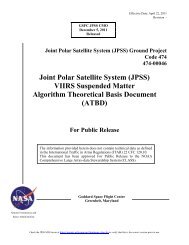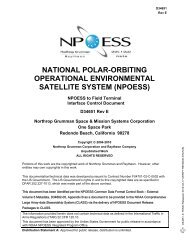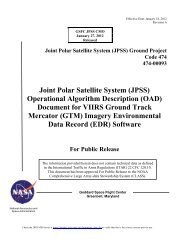(OAD) Document for Ozone Mapping and Profiler Suite ... - NASA
(OAD) Document for Ozone Mapping and Profiler Suite ... - NASA
(OAD) Document for Ozone Mapping and Profiler Suite ... - NASA
You also want an ePaper? Increase the reach of your titles
YUMPU automatically turns print PDFs into web optimized ePapers that Google loves.
<strong>OAD</strong> – OMPS TC EDR D37031<br />
Rev C5<br />
Page 30<br />
above 80 degrees. Although the per<strong>for</strong>mance requirements <strong>for</strong> the OMPS total column<br />
sensor-algorithm system are only valid up to 80 degrees, the algorithm per<strong>for</strong>ms<br />
retrievals up to 88 degrees.<br />
� If the OMPS sensor is in an ascending orbit <strong>and</strong> the retrieval is per<strong>for</strong>med on the<br />
descending portion. Alternatively, if the OMPS sensor is in a descending orbit <strong>and</strong> the<br />
retrieval is per<strong>for</strong>med on the ascending portion.<br />
� If the surface reflectivity is a fill value, the retrieval is not per<strong>for</strong>med <strong>and</strong> a fill value is<br />
indicated.<br />
Finally, a set of flags should indicate the following conditions. Note that the following flags DO<br />
indicate the retrievals are degraded in quality.<br />
� External temperature profile EDR from CrIMSS was not available <strong>for</strong> all Umkehr layers<br />
<strong>for</strong> an FOV.<br />
� External cloud pressure EDR from VIIRS was not available <strong>for</strong> an FOV.<br />
� External snow/ice EDR from VIIRS was not available <strong>for</strong> an FOV.<br />
Data Quality Monitoring<br />
Each algorithm uses specific criteria contained in a Data Quality Threshold Table (DQTT) to<br />
determine when a Data Quality Notification (DQN) is produced. The DQTT contains the<br />
threshold used to trigger the DQN as well as the text contained in the DQN. If a threshold is<br />
met, the algorithm stores a DQN in DMS indicating the test(s) that failed <strong>and</strong> the value of the<br />
DQN attribute. For more algorithm specific detail refer to the CDFCB-X.<br />
2.1.5 Computational Precision Requirements<br />
Because the OMPS TC EDR algorithm is based on an older heritage algorithm, it is coded to<br />
use single precision (‘real’ <strong>and</strong> ‘integer’) declared variables. Double precision real variables or<br />
long integers are not required <strong>for</strong> computational accuracy.<br />
2.1.6 Algorithm Support Considerations<br />
2.1.6.1 Numerical Computation Considerations<br />
Although the TC EDR algorithm contains several iterative loops, the algorithm is not<br />
computationally intensive. Double precision computations are not required.<br />
2.1.6.2 Software Environment Considerations<br />
Fortran90 <strong>and</strong> C++ compilers are necessary to compile the source code <strong>for</strong> the TC IP/EDR<br />
Algorithm <strong>and</strong> supporting modules.<br />
2.1.6.3 SOI Future Development<br />
The algorithm currently uses a set of SO2 absorption cross-sections interpolated from TOMS<br />
values. The channel averaged absorption cross-sections must be recalculated <strong>for</strong> OMPS<br />
specific wavelengths <strong>and</strong> spectral b<strong>and</strong>passes.






